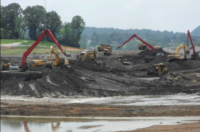More than 14 years after a catastrophic coal-ash spill from a storage site at the Tennessee Valley Authority’s Kingston, Tenn., power plant, its then cleanup contractor, Jacobs, has agreed to settle claims by workers that the company did not protect their health in remediating 5.4 million cu yd of claimed toxic material spread across 300 acres and into the Emory River.
“In 2023, to avoid further litigation, the parties chose to enter into an agreement to resolve the cases. The terms of this settlement are confidential,” the company said in a statement regarding its work responding to the 2008 disaster and the long-running litigation that resulted.
No settlement notice has yet been filed in federal court, so details of the deal remain unclear. Workers rejected at least three prior Jacobs settlement offers, including one in late 2021 of $35 million.
TVA hired Jacobs in 2009 to provide program management services for the cleanup, along with other firms—ultimately paying more than $1 billion to have the site remediated. The utility was not a party to the Jacobs’ workers lawsuit.
While the Centers for Disease Control says silica causes lung disease, the U.S. Occupational Safety and Health Administration says there are acceptable levels of silica exposure but also exposure limits and times when respiratory protection must be provided by employers. The workers claimed, however, they were not allowed respirators while working.
Plaintiffs claimed Jacobs willfully exposed them to fly ash, which includes arsenic, silica quartz, aluminum oxide, iron oxide and calcium oxide and other toxins. They also claimed in a 2013 complaint that the company “engaged in intentional improper air monitoring of fly ash in violation of federal and state laws.” Specifically, the workers said they were intentionally deprived of adequate safety training and protective equipment.
According to local press reports, more than 50 of the workers have died and more than 150 are sick.
Extended Litigation
Jacobs had denied the claims but was found guilty in 2018 of failing to protect workers, with a jury ruling that it did not exercise reasonable care under its estimated $40-million cleanup contract with TVA. The verdict allowed workers to seek damages from the company in a second trial.
Workers were required to prove in that trial that their exposures were a significant factor in causing their illnesses. The previous verdict had found that the actions by the company could cause certain illnesses but not that they were the actual cause. Jacobs also denied the connection.
That trial was under way in a Knoxville, Tenn., federal court when a judge opted to pause proceedings last year to have Tennessee's Supreme Court determine whether cleanup workers can sue for damages, based on a determination under state law if coal ash was comprised of mostly toxic materials or mostly silica, which is not regulated as hazardous.
The settlement was made before the state court ruled on the composition issue. According to one local account, soon after Tennessee Gov. Bill Lee (R) named Dwight Tarwater, Jacobs’ chief counsel in the Kingston litigation, to replace a retiring state supreme court justice, case attorneys filed a stay with that court, which the media report termed "the first clue a settlement might be in the works."
If the statute had applied, "many of the plaintiffs’ suits [would] be dismissed,” says Christopher Robinette, a professor at Southwestern Law School in Los Angeles and an expert in tort law and theory.
In a joint statement, the case attorneys said "parties have entered into a confidential settlement agreement which will resolve all of the cases.”
The U.S. Environmental Protection Agency does not regulate coal ash as hazardous. But earlier this month, EPA proposed a new mandate to make hundreds of inactive US coal ash disposal sites subject to federal safety regulations. The rule would apply to inactive surface impoundments—ponds, landfills and other fill sites at coal-fired power plants no longer operating or that did not accept coal ash waste prior to implementation of the agency’s 2015 rule governing management of that waste.
At present, that rule exempts inactive and legacy disposal sites from federal monitoring, closure and cleanup requirements—even though some have been identified as the source of groundwater contamination through leaks and structural failures.






Post a comment to this article
Report Abusive Comment